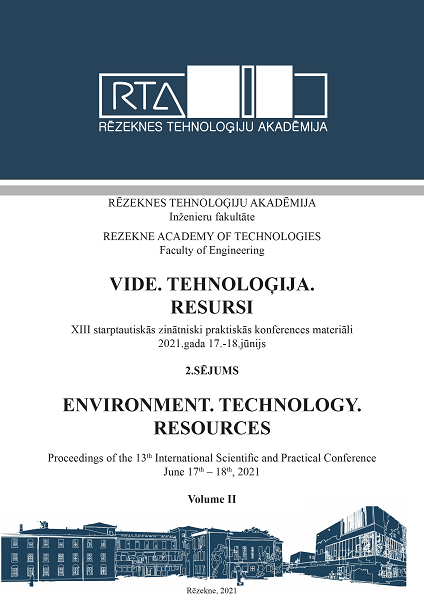PROPOSAL OF FORMAL AND NON-FORMAL EDUCATION FOR NEW GENERATION DIGITAL LEARNING DEMAND IN ENGINEERING
DOI:
https://doi.org/10.17770/etr2021vol2.6646Keywords:
Millennial generation, formal, non-formal education, digital learning, engineeringAbstract
Millennial generation, starting from twelve-year-olds up to adolescents, is one of the most complicated generational cohorts; its ecosystem, beyond of formal and non-formal education boundaries, is more diverse than for any other previous generation.
Digital learners prefer a digital learning environment, as the advantage of digital learning is the control over time, place, way and pace, enabling you to impersonate as an educational institution, applying smart personal network which consists of 3 domains: applied smart technologies; reflexive pedagogy for the digital century [1]; learning environment [2], thus without any confrontation of formal and non-formal education, but rather with consolidation of resources to promote engineering development of formal environment at school, higher educational establishments and informal activities – projects, scientists’ night events, open days, interest-related education programmes, etc.
Goal of the research is to analyse the proposal of formal and non-formal education for the new generation digital learning demand and identify the examples of good practice in engineering, based on the identified digital leaning criteria obtained as a result of theoretical analysis.
Millennial generation, starting from twelve-year-olds up to adolescents, is one of the most complicated generational cohorts; its ecosystem, beyond of formal and non-formal education boundaries, is more diverse than for any other previous generation.
Digital learners prefer a digital learning environment, as the advantage of digital learning is the control over time, place, way and pace, enabling you to impersonate as an educational institution, applying smart personal network which consists of 3 domains: applied smart technologies; reflexive pedagogy for the digital century [1]; learning environment [2], thus without any confrontation of formal and non-formal education, but rather with consolidation of resources to promote engineering development of formal environment at school, higher educational establishments and informal activities – projects, scientists’ night events, open days, interest-related education programmes, etc.
Goal of the research is to analyse the proposal of formal and non-formal education for the new generation digital learning demand and identify the examples of good practice in engineering, based on the identified digital leaning criteria obtained as a result of theoretical analysis.
In the design research of cross-sectional study 323 respondents took part: 226 representatives of formal education and 97 representatives of non-formal education.
In the research the quantitative and qualitative data collection (questionnaires, case analysis) and processing (nonparametric software in SPSS environment and content analysis) methods have been applied.
Results of Mann-Whitney U-test to two independent samples confirm statistically significant differences depending on the respondents’ profile: representatives of non-formal education tend to value
Higher such digital learning criteria as situational
and authentic, whereas representatives of formal education value higher interactive digital learning on demand, which is related to application of different media platforms (p≤0.05).
The research analyses the examples of good practice in case studies in engineering.
Engineering can be geared towards fundamental research, but in the pupils’ educational process the innovative solutions of technical sciences with a perspective of practical applicability arouse a greater interest. Learning efficiency and acquisition of new knowledge are successful if learning is linked to research work in higher educational establishments and transfer of findings in the education system in close collaboration with representatives of economic sectors and businesses.
Downloads
References
M. Kalantzis and B. Cope, Introduction: The Digital Learner-Towards a Reflexive Pedagogy. . In M. Montebello (Ed.), Handbook of Research on Digital Learning (pp. 18-31). IGI Global. 2020
Montebello, M. (2020). I Am the Institution: A Personal Learning Environment. In M. Montebello (Ed.), Handbook of Research on Digital Learning (pp. 291-301). IGI Global.
J.E. Côté, “The dangerous myth of emerging adulthood: An evidence-based critique of a flawed developmental theory”, Applied Developmental Science, vol. 18(4), pp.177–188, 2014.
J. Rifkin, The Age Of Access: The New Culture of Hypercapitalism, Where All of Life is a Paid-For Experience, Putnam Publishing Group, 2000.
E. Duda and K. Dziurzyński, “Digital competence learning in secondary adult education in Finland and Poland”, International Journal of Pedagogy Innovation and New Technologies, vol. 6(2), pp.22-32, 2019.
P.A. Kirschner and P. Bruyckere, “The myths of the digital native and the multitasker”, Teaching and Teacher Education, vol. 67, 135-142, 2017.
L. Daniela, A. Visvizi, C. Gutiérrez-Braojos., and M.D. Lytras, “Sustainable Higher Education and Technology-Enhanced Learning (TEL)”, Sustainability, vol. 10(11), 3883, 2019.
R. Birzina and T. Pigozne, “Technology as a Tool in STEM Teaching and Learning” in Rural Development, Education, Personality, Jelgava, 08.-09.05.2020, pp. 219-227, 2020.
Engineering class 7, 2020. [Online]. Available: https://mape.skola2030.lv/resources/164 [Accessed March 15, 2021].
Education Law, 1999. [Online]. Available: https://likumi.lv/ta/en/en/id/50759 [Accessed March 13, 2021].
A. Jain, “Don't Teach Me, Let Me Learn! Millennial Learning”, Indore Management Journal vol. 8(1), pp. 64–71, 2016.
V. Harju, A. Koskinen, and L. Pehkonen, “An exploration of longitudinal studies of digital learning”, Education Research, vol. 61(4), 388-407, 2019.
G.L. Witt and D.E. Baird, The Gen Z Frequency: How Brands Tune In and Build Credibility, United Kingdom, 2018.
A. Hanif, F.Q. Jamal, and M. Imran, “Extending the Technology Acceptance Model for Use of e-Learning Systems by Digital Learners”, EEE Access, vol. 6(1), pp. 73395-73404, 2018.
P. Faustino and D. Simões, “The Contribution of the Technology Acceptance Model for an Active Teaching and Learning Process in Higher Education: A Bibliometric Analysis” in M. Montebello (Ed.), Handbook of Research on Digital Learning, IGI Global, pp. 242-261, 2020.
C.A. Bohinski, C.A. “Click here for L2 learning!” in Pixel (Ed.) Conference proceedings: ICT for Language Learning, Padova, Italy: Libreriauniversitaria.it, pp.144–148, 2014.
C.A. Lenkaitis, “Valuing technology in the L2 classroom: Student and teacher perceptions, preferences, and digital identity” in M. Montebello (Ed.), Handbook of Research on Digital Learning, IGI Global, pp. 173-189, 2020.
C. Damsa, “Learning with digital technologies in higher education”, Journal of Educational, Sciences and Psychology, vol. 9(71), pp. 5-9, 2019.


